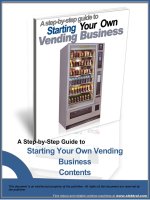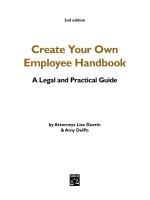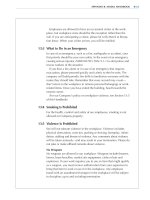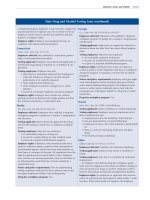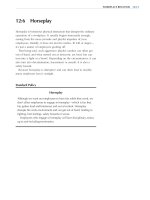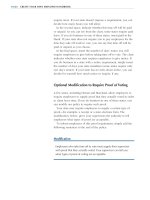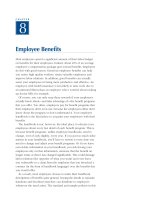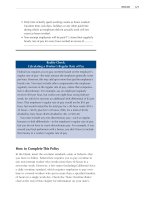create your own employee handbook a legal and practical guide phần 1 potx
Bạn đang xem bản rút gọn của tài liệu. Xem và tải ngay bản đầy đủ của tài liệu tại đây (622 KB, 41 trang )
About Nolo
Have a legal question? Chances are Nolo can help you answer it, both in print
and online.
For three decades, Nolo's mission has been to help people solve their legal
problems with confidence, a minimum of fuss and expense, and—whenever
possible—without a lawyer.
Over the years, we’ve offered every tool available to help you get the job done.
In the 70s, we began publishing practical, plain-English books containing all the
forms and step-by-step instructions necessary to tackle day-to-day legal tasks.
In the 80s, when personal computers took the world by storm, we got to work
and developed programs such as WillMaker and Living Trust Maker, which took
advantage of the speed and convenience of all those bits and bytes. We also
added form-packed disks and CDs to many of our books.
Then the Internet exploded in the 90s. Recognizing that it's best to get legal
information while sitting in your own comfy chair, Nolo started making useful,
up-to-date legal information available to anyone with a computer and a modem.
Most recently, we opened our online Download Center, where you can find
all of Nolo's convenient, topical eProducts. The fastest, easiest way to do your
own legal work, eProducts deliver specific forms and information directly to
your computer.
Does this mean we plan to abandon our books in print? Absolutely not. As
technology evolves and the Internet expands, we will continue to redesign
and improve all our current products, making your access to the law the best
it can be.
“America’s leading source of self-help legal
information.” ★★★★
—YAHOO!
LEGAL INFORMATION
LEGAL INFORMATION
ONLINE
ONLINE
ANYTIME
ANYTIME
www.nolo.com
AT THE NOLO.COM SELF-HELP LAW CENTER, YOU’LL FIND
•
Nolo’s comprehensive Legal Encyclopedia filled with plain-English
information on a variety of legal topics
•
Nolo’s Law Dictionary—legal terms
without the legalese
•
Auntie Nolo—if you’ve got questions, Auntie’s got answers
•
The Law Store—over 200 self-help legal products including
Downloadable Software, Books, Form Kits and eGuides
•
Legal and product updates
•
Frequently Asked Questions
•
NoloBriefs, our free monthly email newsletter
•
Legal Research Center, for access to state and federal statutes
•
Our ever-popular lawyer jokes
Law Books & Software
for Everyone
Nolo’s user-friendly products are consistently first-rate. Here’s why:
•
A dozen in-house legal editors, working with highly skilled authors,
ensure that our products are accurate, up-to-date and easy to use
•
We continually update every book and software program
to keep up with changes in the law
•
Our commitment to a more democratic legal system informs all of our work
•
We appreciate & listen to your feedback. Please fill out and
return the card at the back of this book.
Quality
Our
“No-Hassle”
Guarantee
Return anything you buy
directly from Nolo for any
reason and we’ll cheerfully re-
fund your purchase price.
No ifs, ands or buts.
24
24
h urs a day
h urs a day
h
Read This First
T
he information in this book is as up-to-date and accurate as we can make
it. But it’s important to realize that the law changes frequently, as do fees,
forms and procedures. If you handle your own legal matters, it’s up to you to be
sure that all information you use—including the information in this book—is
accurate. Here are some suggestions to help you:
First, make sure you’ve got the most recent edition of this book. To learn
whether a later edition is available, check the edition number on the book’s
spine and then go to Nolo’s online Law Store at www.nolo.com or call Nolo’s
Customer Service Department at 800-728-3555.
Next, even if you have a current edition, you need to be sure it’s fully up to
date. The law can change overnight. At www.nolo.com, we post notices of major
legal and practical changes that affect the latest edition of a book. To check for
updates, find your book in the Law Store on Nolo’s website (you can use the “A
to Z Product List” and click the book’s title). If you see an “Updates” link on the
left side of the page, click it. If you don’t see a link, that means we haven’t posted
any updates. (But check back regularly.)
Finally, we believe accurate and current legal information should help you
solve many of your own legal problems on a cost-efficient basis. But this text is
not a substitute for personalized advice from a knowledgeable lawyer. If you
want the help of a trained professional, consult an attorney licensed to practice
in your state.
Create Your Own
Employee Handbook
A Legal and Practical Guide
by Attorneys Lisa Guerin & Amy DelPo
1st edition
First Edition APRIL 2003
Editor ILONA BRAY
Cover Design TONI IHARA
Book Design TERRI HEARSH
CD-ROM Preparation JENYA CHERNOFF
ANDRÉ ZIVKOVICH
Index SUSAN CORNELL
Proofreading ROBERT WELLS
Printing ARVATO SERVICES, INC.
Guerin, Lisa, 1964-
Create your own employee handbook : a legal & practical guide / by Lisa Guerin & Amy DelPo
p. cm.
Includes index.
ISBN 0-87337-916-0
1. Employee orientation. 2. Employees Training of. I. DelPo, Amy, 1967- II. Title.
HF5549.5.I53D45 2003
658.3'01 dc21
2003042107
Copyright © 2003 by Nolo.
ALL RIGHTS RESERVED. Printed in the U.S.A.
No part of this publication may be reproduced, stored in a retrieval system, or transmitted in any form
or by any means, electronic, mechanical, photocopying, recording or otherwise without prior written
permission. Reproduction prohibitions do not apply to the forms contained in this product when
reproduced for personal use.
For information on bulk purchases or corporate premium sales, please contact the Special Sales
Department. For academic sales or textbook adoptions, ask for Academic Sales. Call 800-955-4775 or
write to Nolo at 950 Parker Street, Berkeley, CA 94710.
Acknowledgments
The authors would like to thank the following people who helped to make this book
possible:
•Our editor, Ilona Bray, whose good humor and easy nature made the editing
process fun—and whose words and insights never failed to improve upon what
we gave her
•Mary Randolph, for helping us in the beginning to mold and formulate our
vision of this book
• Nolo jack-of-all-trades Stan Jacobson, who tirelessly haunted libraries through-
out the Bay Area to meet our research needs
• Andre Zivkovich and Jenya Chernoff, who managed to take our printed pages
and turn them into a CD-ROM that people could use on their computers
• Terri Hearsh, for working with us on a wonderful book design, and
• Robert Wells, for his meticulous proofing.
In addition, Amy would like to dedicate her work on this book to her daughter,
Sophia, whose early birth delayed this book by almost half a year. She is everything
and more.
About the Authors
Lisa Guerin worked for Nolo as a research and editorial assistant during her years as
a law student at Boalt Hall School of Law. After a stint as a staff attorney at the U.S.
Court of Appeals for the Ninth Circuit, Lisa worked primarily in the field of employ-
ment law, in both government and private practice. Lisa has litigated on behalf of her
clients in all levels of state and federal courts and in agency proceedings. Lisa recently
returned to Nolo as an editor, where she specializes in employment law and civil
litigation.
Amy DelPo practiced law for six years before leaving the day-to-day grind of lawsuits
to join Nolo’s editorial staff in 2000. As an attorney, she specialized in employment
law and general civil litigation, representing her clients in all levels of state and federal
courts. At Nolo, she continues her work in the field of employment law, authoring
and editing a number of books on the subject, including the best-selling The Employer’s
Legal Handbook, by Fred Steingold. She also added retirement planning and
independent contractor law to her fields of expertise, editing a number of books on
these subjects.
Together, the authors have written Dealing with Problem Employees, Everyday
Employment Law: The Basics and Federal Employment Laws: A Desk Reference, all
published by Nolo.
I
Introduction
A. What an Employee Handbook Can Do for Your Business I/2
B. Who Can Use This Book I/6
C. Icons Used in This Book I/6
H
How to Use This Book
A. What You’ll Find in This Book H/2
B. What You Won’t Find in This Book H/3
C. The Creation Process H/4
1
Handbook Introduction
1:1 Welcoming Statement 1/2
1:2 Introduction to the Company 1/4
1:3 History of the Company 1/6
1:4 Handbook Purpose 1/8
1:5 Bulletin Board 1/10
2
At-Will Protections
2:1 At-Will Policy 2/3
Form A: Handbook Acknowledgment Form 2/6
Table of Contents
3
Hiring
3:1 Equal Opportunity 3/2
3:2 Recruitment 3/4
3:3 Internal Application Process 3/6
3:4 Employee Referral Bonus Program 3/7
3:5 Nepotism 3/10
4
New Employee Information
4:1 New Employee Orientation 4/2
4:2 Orientation Period 4/3
4:3 Work Eligibility 4/7
4:4 Child Support Reporting Requirements 4/9
5
Employee Classifications
5:1 Temporary Employees 5/2
5:2 Part-Time and Full-Time Employees 5/4
5:3 Exempt and Non-Exempt Employees 5/5
6
Hours
6:1 Hours of Work 6/2
6:2 Flexible Scheduling (“Flextime”) 6/4
6:3 Meal and Rest Breaks 6/6
6:4 Overtime 6/8
7
Pay Policies
7:1Payday 7/2
7:2 Advances 7/5
Form B: Payroll Deduction Authorization Form 7/9
7:3 Tip Credits 7/10
7:4 Tip Pooling 7/11
7:5 Shift Premiums 7/13
7:6 Payroll Deductions 7/14
7:7 Wage Garnishments 7/15
7:8 Expense Reimbursement 7/16
Form C: Expense Reimbursement Form 7/20
8
Employee Benefits
8:1 Employee Benefits: Introductory Statement 8/3
8:2 Domestic Partner Coverage 8/5
8:3 Healthcare Benefits 8/7
8:4 Disability 8/9
8:5 Workers’ Compensation 8/10
8:6 Unemployment Insurance 8/11
9
Use of Company Property
9:1 Use of Company Property: In General 9/2
9:2 Company Car 9/3
9:3 Telephones 9/5
9:4 Return of Company Property 9/6
10
Leave and Time Off
10:1 Vacation 10/2
10:2 Holidays 10/5
10:3 Sick Leave 10/7
10:4 Paid Time Off 10/10
10:5 Family and Medical Leave 10/14
10:6 Bereavement Leave 10/19
10:7 Military Leave 10/20
10:8 Time Off to Vote 10/23
10:9 Jury Duty 10/25
11
Performance
11:1 Job Performance Expectations 11/2
11:2 Job Performance Reviews 11/4
12
Workplace Behavior
12:1 Professional Conduct 12/2
12:2 Punctuality and Attendance 12/4
12:3 Dress, Grooming and Personal Hygiene 12/6
12:4 Pranks and Practical Jokes 12/10
12:5 Threatening, Abusive or Vulgar Language 12/12
12:6 Horseplay 12/13
12:7 Fighting 12/14
12:8 Sleeping on the Job 12/15
12:9 Insubordination 12/17
12:10Progressive Discipline 12/19
13
Health and Safety
13:1 Workplace Safety 13/2
13:2 Workplace Security 13/4
13:3 What to Do in an Emergency 13/7
13:4 Smoking 13/9
13:5 Violence 13/13
14
Employee Privacy
14:1 Workplace Privacy 14/3
14:2 Telephone Monitoring 14/5
15
Computers, Email and the Internet
15:1 Email 15/2
15:2 Internet Use 15/10
Form D: Email and Internet Policy Acknowledgment 15/15
15:3 Software Use 15/16
16
Employee Records
16:1 Personnel Records 16/2
16:2 Confidentiality 16/3
16:3 Changes in Personal Information 16/4
16:4 Inspection of Personnel Records 16/5
16:5 Work Eligibility 16/7
16:6 Medical Records 16/8
17
Drugs and Alcohol
17:1 Prohibition Against Drug and Alcohol Use at Work 17/3
17:2 Inspections to Enforce Policy Against Drugs and Alcohol 17/7
17:3 Drug Testing 17/8
17:4 Leave for Rehabilitation 17/10
17:5 Rehabilitation and Your EAP 17/13
18
Trade Secrets and Conflicts of Interest
18:1 Confidentiality and Trade Secrets 18/3
18:2 Conflicts of Interest 18/6
19
Discrimination and Harassment
19:1 Anti-Discrimination Policy 19/2
19:2 Harassment 19/6
20
Complaint Policies
20:1 Complaint Procedures 20/2
20:2 Open-Door Promise 20/4
21
Ending Employment
21:1 Final Paychecks 21/2
21:2 Severance 21/4
21:3 Insurance Continuation 21/6
21:4 Exit Interviews 21/9
21:5 References 21/12
Appendix
A
How to Use the CD-ROM
A. Installing the Handbook Section Files Onto Your Computer A/3
B. Using the Handbook Section Files to Create an Employee Handbook A/4
C. Files Included on the Employee Handbook CD A/8
B
Model Handbook
Section 1: Introduction B/2
Section 2: Nature of Employment B/5
Section 3: Hiring Practices B/6
Section 4: Information for New Employees B/8
Section 5: Classifications of Employees B/10
Section 6: Hours B/12
Section 7: Pay Policies B/14
Section 8: Employee Benefits B/16
Section 9: Use of Company Property B/19
Section 10: Leave and Time Off B/21
Section 11: Employee Job Performance B/26
Section 12: Workplace Behavior B/27
Section 13: Health and Safety B/32
Section 14: Employee Privacy B/35
Section 15: Computers, Email and the Internet B/36
Section 16: Employee Records B/39
Section 17: Drugs and Alcohol B/41
Section 18: Trade Secrets and Conflicts of Interest B/44
Section 19: Discrimination and Harassment B/46
Section 20: Complaint Policies B/48
Section 21: Ending Employment B/50
C
Where to Go for Further Information
Departments of Labor C/2
Agencies That Enforce Laws Prohibiting Discrimination in Employment C/6
Index
I
Introduction
If you’re like most employers, you (or people who work for you)
probably devote a good part of every day to employee relations.
You may find yourself making decisions or relaying information
about everything from benefits to vacation time to disciplinary
problems. Sometimes, you may know the answer right away (“You
get ten vacation days”); other times, you may have to think a bit or
come up with something new (“What is our policy on paternity
leave?”).
In such situations, a good employee handbook is as essential as
any real live member of your management team. It knows all the
answers—and it communicates them clearly to your employees.
Indeed, an employee handbook can do a lot for you, such as:
• save you time by cutting down on the number of questions
employees ask every day
• ensure that you treat your employees consistently, and
• give you legal protection when an employment relationship
goes sour.
We talk more about these benefits in Section A, below; we
explain how this book can help you create an effective handbook
in Section B.
A. What an Employee Handbook Can
Do for Your Business I/2
B. Who Can Use This Book I/6
C. Icons Used in This Book I/6
I/2 CREATE YOUR OWN EMPLOYEE HANDBOOK
A. What an Employee Handbook Can
Do for Your Business
Simply defined, an employee handbook is a written document
describing the benefits and responsibilities of the employment
relationship. In reality, however, the handbook’s role is much more
complex and powerful. While it sits quietly on the shelf, the
employee handbook can actually help you manage and control
your relationship with your employees.
1. The Purposes of an Employee Handbook
An employee handbook is an indispensable workplace tool, because
it can help you communicate with your employees, manage your
workforce (and your managers), streamline your organization and
protect your business from lawsuits. We cover each of these benefits
in detail below.
a. Communication
Your handbook tells your employees what your company expects
from them and what they can expect from the company. “What
time do I have to be at work?” “Does my employer provide health
insurance?” “How do I complain about my supervisor’s sexual
advances?” A well-drafted handbook will answer all of these
questions and many more.
In addition to relaying basic information about benefits, hours
and pay, your employee handbook imparts your company’s culture,
values and history. When was your company founded? Why do you
think it is successful? What attitude do you want your employees to
take towards their jobs and customers?
As you take our standard policies and modify them to suit your
workplace, remember this most basic and obvious aspect of
employee handbooks: Through the written policies, you are talking
to your employees. Make sure you are saying what you want to
say in the way you want to say it.
b. Management
Workers are not mind readers. Although you may know what your
practices and policies are, without a handbook, employees, managers
and supervisors have no place to turn for this information. This
creates an environment ripe for trouble, both legal and practical.
Employee morale will drop if some employees are treated differently
INTRODUCTION I/3
from others, and you might find yourself involved in a discrimination
lawsuit if employees think that this inconsistent treatment is based
on race, gender or some other protected characteristic.
Handbooks promote positive employee relations by ensuring
that all of your employees get treated consistently and fairly. They
prevent misunderstandings, confusion and complaints by giving
everyone in your workplace the same resource for learning your
personnel practices. If there is ever any doubt or dispute about a
particular policy, you can simply open the book and take a look.
You don’t need to have long, agonizing discussions or try to rein-
vent the wheel.
c. Planning
The process of creating your handbook will force you to think
about every aspect of your relationship with your employees. Rather
than doing things just because that’s the way they’ve always been
done, you can reflect on how you have been treating your employees
and decide whether any changes are in order. For each policy, ask
yourself: Do I really want to continue doing things this way? If so,
why?
Creating an employee handbook necessarily requires you to
communicate with, and get feedback from, supervisors and
employees about your current personnel practices. In this way, you
learn what works and what doesn’t, what is enhancing employee
morale and what is dampening it.
d. Legal Protection
Just having a handbook on your shelf can help you comply with
the law and cut your risk of lawsuits:
• Some laws require employers to communicate certain infor-
mation to their employees. The handbook provides you with
a convenient place to put this information.
• Even when you aren’t required to give information to your
employees, there are times when you can protect yourself by
providing it. For example, no law requires you to tell your
employees how to complain about sexual harassment, but if
you do, you can use the complaint policy as a defense should
someone ever sue you. (You can find a sexual harassment
policy in Chapter 19.)
• Your policies can affirm your commitment to equal employ-
ment opportunity laws. This is one step toward creating a
tolerant and discrimination-free workplace—something that
most employers are legally obligated to do. (You can find
standard equal employment opportunity policies in Chapter 3.)
I/4 CREATE YOUR OWN EMPLOYEE HANDBOOK
• In certain situations, your company will be responsible for
the actions of its employees and supervisors who violate the
law, even if the company did not condone or even know about
the illegal conduct. Cut down the risk of unlawful behavior
by providing guidance and prohibitions in your handbook.
Perhaps the most important reason to have an employee hand-
book is to protect your legal right to terminate employees at will.
In theory, you already have this right. Unless you have entered
into a contract with an employee promising something else, your
relationship with that employee is automatically at will—meaning
you can terminate the employment relationship at any time for any
reason that is not illegal, and the employee can do the same.
However, the absence of a written contract doesn’t fully protect
you. You can inadvertently destroy your right to terminate at will
by creating an implied contract with your employees, promising
not to fire them unless you have a legitimate business reason.
Some employers with badly written handbooks have gotten burned
over this issue. Courts have found that certain statements in their
handbooks—including that employees will only be fired for certain
reasons, that employees won’t be fired if they are doing a good job
or that employees are considered “permanent”—created implied
contracts that limited the employers’ right to fire at will. (For more
on at-will employment and implied contracts, see Chapter 2.)
In this book, we help you avoid this trap by providing you with
standard policies that steer clear of any promises of continued
employment and by providing disclaimers that specifically state
that employment relationships at your company are at will.
2. What an Employee Handbook Is Not
Your handbook can do a lot, but it can’t do everything, nor should
it. As we explain more fully in this section, a handbook is just one
piece of your employee relations picture. It’s up to you, your-
managers and supervisors to provide the other pieces.
a. Your Handbook Is No Substitute for You
Although your handbook is an important communication tool, it
cannot take the place of one-on-one personal interaction between
you and the people who work for you. If you want good employee
relations—that is, if you want your employees to trust you and feel
loyal to you—your employee handbook can help, but it can’t do
the job on its own. Your employees need a human face behind the
policies. They need to see and hear from you and to feel that you
are interested in them and the job they are doing.
INTRODUCTION I/5
b. Your Handbook Is No Substitute for Good Practices
No matter how many policies you write, they won’t do you any
good unless you follow them. In fact, they might actually do some
harm.
From a practical standpoint, personnel practices that are incon-
sistent with written policies can damage employee relations.
Employees who read one thing but experience another won’t
trust—or feel loyal to—their employer.
From a legal standpoint, you are courting trouble if you don’t
deliver what you promise in your handbook. Even though you will
have disclaimers in your handbook telling employees that the
handbook is not a contract (see Chapter 1 for these disclaimers), you
can’t predict when a judge or jury will think differently and try to
hold you to your words—or at least make you pay for not following
them. For these reasons, you should include in your handbook
only those policies that you are prepared to follow.
c. Your Handbook Is Not a Personnel Policy Manual
Employee handbooks are written in general terms, for use by
employees. A policy or procedures manual, on the other hand, is a
detailed guide that sets out very specifically how supervisors and
managers are to do their jobs in your company. Usually, employees
are not allowed access to these manuals.
You may wonder why you can’t just have one book for both
audiences. There are a number of reasons:
• There might be sensitive information (on pay scales, for
example) that you don’t necessarily want to reveal to your
employees.
•Employees don’t need to know every little detail of how
things are done. If you throw too much information at your
employees—some of it irrelevant to their day-to-day work—
they might get overwhelmed and not read the handbook at
all.
• The details of how you implement policies are more likely to
change than the general policies themselves. If you put these
details in your handbook, you limit your ability to change
how things are done.
I/6 CREATE YOUR OWN EMPLOYEE HANDBOOK
B. Who Can Use This Book
This book is for business owners, managers, supervisors and human
resource professionals in any size company, from a small outfit
with only a handful of employees to a large corporation. It is also
appropriate for virtually every industry, from manufacturing to
sales to service provision.
There are two types of workplaces for which this book won’t
work: public workplaces (that is, workplaces with federal, state or
local government employees) and unionized workplaces.
C. Icons Used in This Book
To aid you in using this book, we use the following icons:
The caution icon warns you of potential problems.
This icon indicates that the information is a useful tip.
This icon refers you to helpful books or other resources.
This icon indicates when you should consider consulting an
attorney or other expert.
This icon refers you to a further discussion of the topic
somewhere else in this book.
■
H
How to Use This Book
If you’re eager to be the proud owner of an employee
handbook, we should warn you that there is a catch. Well,
two catches: Handbooks don’t write themselves, and there
is no such thing as a “one size fits all” handbook. You
can’t simply purchase a generic handbook, slap your
company’s name on the cover and distribute it to your em-
ployees. If you want an effective handbook for your
workplace, you are going to have to sit down and actually
create it, with policies and language that reflect your
company’s culture, values and personnel practices.
Don’t despair, however. We’ve designed this book to make the
process easy and straightforward, taking you step by step through
planning, writing and distributing a handbook. Using this book,
you can create an employee handbook that’s tailored to your
company’s needs, with minimal time and headaches.
In this chapter, we:
• explain what you’ll find in the different parts of this book
(Section A)
• advise you on what information you’ll need to obtain from
other sources (Section B), and
•instruct you on each phase of the handbook creation process,
from gathering the information you’d like to include in your
handbook to picking a distribution method once your hand-
book is complete (Section C).
A. What You’ll Find in This Book H/2
B. What You Won’t Find in This Book H/3
C. The Creation Process H/4
H/2 CREATE YOUR OWN EMPLOYEE HANDBOOK
A. What You’ll Find in This Book
This book is both a workbook and a guidebook. The heart of the
book (Chapters 1 through 21) contains a combination of important
material. First, it contains prewritten personnel policies that you’ll
be able to cut and paste (and modify, if necessary), policy by policy,
into the handbook you’re creating. Along with these prewritten
policies, however, these chapters provides valuable explanatory
material, including:
• background information
• guidance to help you decide whether you want to include
that policy in your handbook
• standard language that you can cut and paste into your
handbook (or, if there is no standard way to word a policy,
an example of what such policies look like and detailed
guidance on writing your own from scratch)
• instructions on completing the standard policy with informa-
tion specific to your workplace
•when appropriate, modifications that you can use to change
the standard policy to suit your needs
• information on potential trouble spots, both practical and
legal, and
• advice on when to consult an attorney for more assistance.
When you’re ready to start compiling your handbook, you’ll find
the prewritten portions on the CD-ROM at the back of this book.
Instructions for using the CD-ROM are in Appendix A.
To see an example of what all the prewritten policies look like
once they’re pulled together, see the model handbook in Appendix
B.
Finally, Appendix C gives you information on where to go for
more assistance.
Don’t jump right to the
CD-ROM. The CD-ROM
contains all of the standard policies
and modifications discussed in this
book. However, you cannot simply
print out those policies verbatim and
distribute them to your employees. If
you do that, you will have wasted
your money, for you will end up with
a handbook that doesn’t accurately
reflect your workplace. Read the
discussions that accompany each
handbook section in this book first,
then cut and paste what you need.
